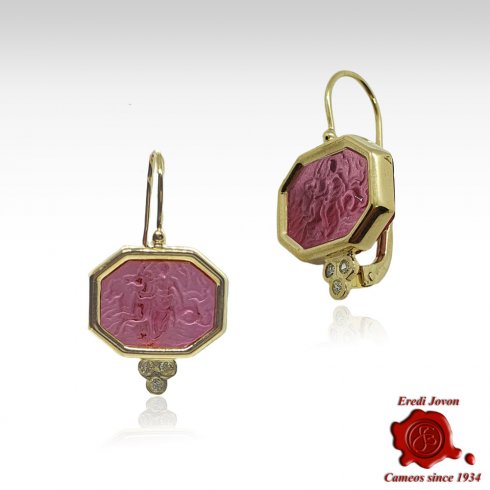Intaglio Jewelry: Venetian Glass in a Cameo

What is Intaglio Jewelry?
First of all ... what is glass paste?
It is a mixture, based on silica, in which sodium, calcium and colored pigments are added and melted by cooking it in a blast furnace at 1300 degrees. Its compound requires very long processing times. The mixture is stirred for up to 18 hours and allowed to cool in particular furnaces, called "tempre", for an entire day. This ensures a gradual return to room temperature, without a sudden heat shock causing it to explode.
Let's investigate more in depth how glass paste creates the intaglio jewelry ... ready? let's go!

The role of glass paste over the centuries
This material has found its role in antique cameo jewelry for hundreds of years. One of the works that have most exalted it, has been undoubtedly intaglio carving, a technique that excavates, through a work of engraving, the surface, creating images.
The art of intaglios comes from far away, from ancient Greece and Rome. It was born in the beginning as a method of creating seals, to be pressed on wax, but soon it was also used in jewelry making. Originally, only semi-precious stones were carved, but glass, which came from trade with the East, became a very valuable alternative.
.png)
And what does this have to do with Venice? In reality everything starts from Aquileia, the Roman city of the famous mosaics declared a World Heritage Site by UNESCO in 1998.
Together with Altino, Aquileia is one of the cities where future Venetians lived before escaping from the barbarian invasions of Attila.

Intaglio Jewelry Made in Italy
The Traditional Intaglio Jewelry Made in Venice since Roman Times
Antique Intaglio JewelryThe period of true splendor for Glass intaglio jewelry begins with the Renaissance, first in France, then in Italy, where the discovery of ancient Roman sites and the unearthing of finds rediscover the taste for the classic motif of Hellenistic mold, made of busts and ethereal faces, in plastic poses, evoking a beauty to contemplate.
In fact, many of the Intaglio jewelry represent mythological scenes and some are even casts of coins or Roman friezes.
Venetian glass intaglios
The highest pinnacle in history certainly comes with Murano glassmaking production. The skill of the creation, by means of diamond-cut engraving, sublimates the nascent French fashion and brings the jewelry sets of the royal courts across the Alps even in the lagoon. Incredibly beautiful pendants, similar to cameos, adorn the beautiful necklines of the Venetian ladies, lively Cameo intaglio earrings appear under the elaborate wigs, a riot of curls and cotton, and theatrical brooches embellish the brocade dresses, whose rustle of skirts fills the streets between the seventeenth and eighteenth centuries.
The Victorian era and Intaglio jewellery
Shortly thereafter, even in England, glass cameo jewelry arrives, and meets a long period of splendor with the Victorian era.
The queen, a deep lover of the goldsmith's art, draws herself some Intaglio cameo pieces, dictating the English fashion of the jewel until the end of the 19th century.
From the fifteenth century to the early '900, then, the miniatures of "carved" images were considered as works of art to be preserved, with a sentimental connotation, because received as a dowry by a father, or because the gift of the beloved, and they have surrounded the whole history of costume with a romantic aura.

Tagliamonte Intaglio Jewelry in Gold
The Traditional Tagliamonte Intaglio Jewelry Traditionally Made in Venice
Tagliamonte Intaglio JewelryJewelry with glass paste
The equation that had always seen the true gem as a symbol to be shown of a wealth destined for a few and as the only subject designated for engraving, is now overturned. With the industrial revolution, the general concept of production is redefined, including in the goldsmith's art. Creations must be more accessible. Jewels can no longer be the exclusive prerogative of high nobility. Glass paste definitely becomes an ideal material for the cause. It lends itself to carvings of great impact, but at a price within the reach of even bourgeoisie people who are about to become the new protagonist.

The role of glass over millennia. From sacred to profane.
Glass is once again the material that passes through time. Always used in Christian iconography to impress and teach: first with mosaics (such as those of Aquileia) and then with the polychrome windows; a believer, through the images, learned the events of the Gospels. Now it becomes an everyday thing, a coquettish symbol of vanity, and enters fully into the world of jewelry.
In Italy everything has its own meaning and, if you have patience, following the threads of history, back in time you discover that the beauty of today is only the result of the heart, art and genius of our ancestors.
As usual, I leave you with the biggest hug in the world and I invite you to download my book on cameos for free and browse through our online catalogue of Antique Intaglio Jewelry
The biggest hug in the World

If you liked this post maybe you'll love as well:
Information
Last post
-

Love Hope Faith Amulet | Meaning and Tradition
Discover the meaning of the Faith, Hope & Charity charm: a timeless amulet to wear every day. A jewel that tells...
-

The Four-Leaf Clover: the rare gift that dares to speak to the heart
Discover the true meaning of the four-leaf clover and its Italian twist with the lucky cornetto charm—a rare story...
-
















